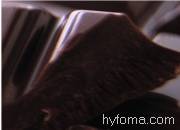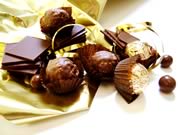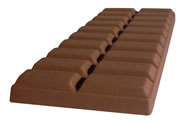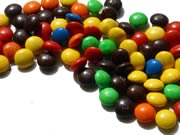Dieser Artikel ist noch nicht auf Deutsch vorhanden
Chocolate
Inhalt
Anything can be called chocolate in the EU, as long as it contains at least 1% chocolate. (In the USA the FDA minimum is 10%.) However the EU said that each bar must state on the label the percentage of cacao that it contains.
Chocolate roasting
The dried, fermented cacao seeds are carefully shipped from their country of origin to the chocolate manufacturing countries. It is very important to keep the seeds dry during shipment. Moisture would encourage further fermentation and rotting. It is worth noting that, like coffee, all of the countries of origin are warm, tropical, and generally poor while the manufacturing countries are cool, northern and wealthy.The beans are carefully cleaned and sorted at the factory, and then roasted. The seeds are put in revolving drums roasters (or hot air roasters) to produce the roasted beans.
For cocoa powder the seeds are roasted at 95 to 125ºC for about an hour; for chocolate bars they are roasted for a somewhat shorter time at a slightly lower temperature.
Waste moisture and acid compounds evaporate during the roasting process, and the beans become a uniform shade of deep-brown. Cacao roasting is a very important stage of the whole manufacturing process, and the future quality of the chocolate, and its smell and taste depend on it just as much as they do on fermentation. Sometimes different grades of cacao (or cacao of one grade, but grown in different countries) are mixed for roasting. The majority of the major chocolate manufacturers keep their methods and conditions of roasting a secret. One hundred kilograms of harvested seed becomes 45 kilograms of roasted beans.
Cacao liquor
After roasting the beans are crushed, broken into tiny fragments called nibs. The fragments of the inner shell are removed from the nibs, usually by air currents. Some processors remove the shell before the first roast, to produce a different flavor. It is common to combine several different cacaos to create a special "blend".Roasted and cleaned nibs are carefully ground. The finer the nibs are ground at this stage, the fuller and finer the taste of the chocolate. The size of the cacao particles passed through the grinding machinery, should not exceed 75 microns - such cacao is called cacao liquor.
Pressing
The cacao liquor contains 54% cocoa butter, the very valuable substance essential for the production of real chocolate. Cacao liquor is heated up to 95−105°C and is then pressed (425 kg/cm2) which removes some or all of the fat (depending on the time pressed). As a result, cocoa butter is separated from the solids. Firm cakes of cacao come out of the press which are then ground again to make the fine cocoa powder. This process, obviously, creates a surplus of cocoa butter, which is used to make chocolate bars and "white chocolate" as well as other products.Mixing and grinding
Cacao liquor, sugar and part of the cocoa butter are mixed in specified proportions. The sugar and other ingredients are added when the cocoa butter is added. After mixing the mass is ground. This stage is very important for the production of chocolate: the finer the crushing, the more delicate the taste. Please note that the overall content of natural cacao-products in such a mix largely determines not only the quality, but also the cost of the chocolate. This especially concerns the contents of cocoa butter, an extremely valuable and expensive product. But in various cheap substitutes cocoa butter is almost invariably absent. It is the reason for the so-called “attractive” prices, which are used by not too scrupulous manufacturers to please not very experienced clients. More extra cocoa butter weakens the chocolate flavor and makes the bar more creamy, less makes it more powdery and flavorful. The challenge, of course, is to make a bar that is both creamy and flavorful.Conching
The whole mass is mixed and ground continually for several hours to make it smooth and to distribute the added cocoa butter evenly over all surfaces of all particles. Swiss chocolate manufacturer Rudolph Lindt created a process of rolling and kneading the gritty, grainy raw cacao paste into the smooth and rich quality that eating chocolate is known for today. The name for this process at high temperature, conching, comes from the shell-like shape of the rollers used. Conching is a very long (16-72 hours) process and, as a result, the superfluous moisture and the residual tannins are evaporated from the chocolate mass, and the cocoa solids are rounded off. The consistency of the chocolate becomes more homogeneous, and the taste gentler, the well-known “melt in the mouth”-effect. After processing, the rest of the components are added according to the recipe: lecithin (for mass attenuation and optimized moulding), natural flavoring agent vanilla (for a subtler and more delicate aroma).Tempering
Tempering is a key part of chocolate production. It is a long and complex process, which requires great experience and skill. After conching, the hot chocolate mass should be cooled, but it requires several stages to do this, because of the cocoa butter contents. The problem is that cocoa butter is a polymorphic fat, which crystallizes and congeals while cooling, but can take on different consistencies according to cooling conditions. Tempering is necessary for the cocoa butter to obtain the most stable consistency. For this purpose, the hot chocolate is at first cooled down to 28°С, and then reheated to 32°С. If the process is upset at any one of the tempering stages, this will be reflected in the appearance and consistency of the chocolate. For example, a characteristic white bloom can appear on its surface. Such a “bloom” is the result of incorrect tempering. Moreover, the “bloom” does not appear at once, but some time later. Also, the chocolate can become hard-grained and crumbly due to incorrect cooling. In this case, its taste properties will be retained, but its appearance for marketing purposes will be hopelessly damaged.Moulding
After tempering, the chocolate is poured into heated moulds. At this stage, if the recipe requires it, various additives (for example, nuts) are put into the chocolate. After that, the chocolate is put into coolers. The chocolate solidifies and a beautiful shine appears on its surface. Then the moulds with the solid chocolate are upturned and shaken on to the conveyor.Packaging and labelling
The last stage in the manufacture of chocolate is its packaging and labeling.Many bars are wrapped in foil, but it gives a metallic taste to the chocolate. However plain paper allows the chocolate to go bad quickly. Some use waxed paper, which is much better -- others have started to use paper-lined, or wax-lined foil.
Storage
Chocolate should be transported and stored at 18°С, with a relative humidity of less than 75%. If these conditions are not observed, the chocolate can bloom and lose its marketable appearance.Shelf life
The same chocolate can taste different at different times. As the bar gets older, especially if it is not wrapped well, it can loose flavour. It can also start to get rancid and taste slightly dirty.After 3 months pretty much loses its flavour. As it gets older the cacao butter also gets rancid. We often find this in organic bars, and especially in bars with an organic unrefined sugar. This could be because the sugar has a strong flavour itself, or because it is making the cacao butter go bad more quickly.
Definitions of terms
Cacao
(also Kakao) From Mayan Cacau- The plant and seeds that produce chocolate
- Chocolate in it's natural form
- The pure processed product before additives are combined with it to form chocolate or candy.
 Nach oben
Nach oben



 Firmen
Firmen



